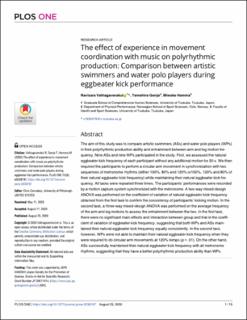| dc.contributor.author | Vathagavorakul, Ravisara | |
| dc.contributor.author | Gonjo, Tomohiro | |
| dc.contributor.author | Homma, Miwako | |
| dc.date.accessioned | 2021-02-10T11:04:20Z | |
| dc.date.available | 2021-02-10T11:04:20Z | |
| dc.date.created | 2020-10-05T15:50:42Z | |
| dc.date.issued | 2020 | |
| dc.identifier.citation | PLOS ONE. 2020, 15(8), e0238197. | en_US |
| dc.identifier.issn | 1932-6203 | |
| dc.identifier.uri | https://hdl.handle.net/11250/2727155 | |
| dc.description | This is an open access article distributed under the terms of the Creative Commons Attribution License (http://creativecommons.org/licenses/by/4.0/), which permits unrestricted use, distribution, and reproduction in any medium, provided the original author and source are credited. | en_US |
| dc.description.abstract | The aim of this study was to compare artistic swimmers (ASs) and water polo players (WPs) in their polyrhythmic production ability and entrainment between arm and leg motion frequency. Nine ASs and nine WPs participated in the study. First, we assessed the natural eggbeater kick frequency of each participant without any additional motion for 20 s. We then required the participants to perform a circular arm movement in synchronization with two sequences of metronome rhythms (either 100%, 80% and 120% or100%, 120% and 80% of their natural eggbeater kick frequency) while maintaining their natural eggbeater kick frequency. All tasks were repeated three times. The participants’ performances were recorded by a motion capture system synchronized with the metronome. A two-way mixed-design ANOVA was performed on the coefficient of variation of natural eggbeater kick frequency obtained from the first task to confirm the consistency of participants’ kicking motion. In the second task, a three-way mixed-design ANOVA was performed on the average frequency of the arm and leg motions to assess the entrainment between the two. In the first task, there were no significant main effects and interaction between group and trial in the coefficient of variation of eggbeater kick frequency, suggesting that both WPs and ASs maintained their natural eggbeater kick frequency equally consistently. In the second task, however, WPs were not able to maintain their natural eggbeater kick frequency when they were required to do circular arm movements at 120% tempo (p < .01). On the other hand, ASs successfully maintained their natural eggbeater kick frequency with all metronome rhythms, suggesting that they have a better polyrhythmic production ability than WPs. | en_US |
| dc.language.iso | eng | en_US |
| dc.subject | musculoskeletal mechanics | en_US |
| dc.subject | asses | en_US |
| dc.subject | arms | en_US |
| dc.subject | body limbs | en_US |
| dc.subject | legs | en_US |
| dc.subject | swimming | en_US |
| dc.subject | sports | en_US |
| dc.subject | analysis of variance | en_US |
| dc.title | The effect of experience in movement coordination with music on polyrhythmic production: Comparison between artistic swimmers and water polo players during eggbeater kick performance | en_US |
| dc.type | Peer reviewed | en_US |
| dc.type | Journal article | en_US |
| dc.description.version | publishedVersion | en_US |
| dc.rights.holder | © 2020 Vathagavorakul et al. | en_US |
| dc.source.journal | PLOS ONE | en_US |
| dc.identifier.doi | 10.1371/journal.pone.0238197 | |
| dc.identifier.cristin | 1837224 | |
| dc.description.localcode | Institutt for fysisk prestasjonsevne / Department of Physical Performance | en_US |
| cristin.ispublished | true | |
| cristin.fulltext | original | |
| cristin.qualitycode | 1 | |
